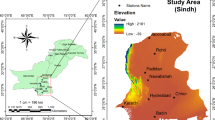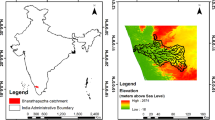Abstract
Skill of a time-varying downscaling approach, namely Time-Varying Downscaling Model (TVDM), against time-invariant Statistical Downscaling Model (SDSM) approach for the assessment of precipitation extremes in the future is explored. The downscaled precipitation is also compared with a Regional Climate Model (RCM) product obtained from Coordinated Regional Climate Downscaling Experiment (CORDEX). The potential of downscaling the extreme events is assessed considering Bhadra basin in India as the study area through different models (SDSM, TVDM and RCM) during historical period (calibration: 1951–2005, testing: 2006–2012). Next, the changes in precipitation extremes during future period (2006–2035) have been assessed with respect to the observed baseline period (1971–2000), for different Representative Concentration Pathway (RCP) scenarios. All the models indicate an increasing trend in the precipitation, for the monsoon months and maximum increase is noticed using RCP8.5. The annual precipitation during the future period (RCP8.5) is likely to increase by 7.6% (TVDM) and 4.2% (SDSM) in the study basin. An increase in magnitude and number of extreme events during the future period is also noticed. Such events are expected to be doubled in number in the first quarter of the year (January–March). Moreover, the time-invariant relationship (in SDSM) between causal-target variables is needed to be switched with time-varying (TVDM). This study proves that the time-varying property in TVDM is more beneficial since its performance is better than SDSM and RCM outputs in identifying the extreme events during model calibration and testing periods. Thus, the TVDM is a better tool for assessing the extreme events.




Similar content being viewed by others
References
Amiri MA, Mesgari MS (2016) Spatial variability analysis of precipitation in Northwest Iran. Arab J Geosci 9(11):578–510. https://doi.org/10.1007/s12517-016-2611-7
Amiri MA, Mesgari MS (2017) Modeling the spatial and temporal variability of precipitation in Northwest. Iran. Atmosphere 8(12: 254):1–14. https://doi.org/10.3390/atmos8120254
Amiri MA, Mesgari MS (2018) Improving the accuracy of rainfall prediction using a regionalization approach and neural networks. Kuwait Journal of Science 45(4):66–75
Amiri MA, Mesgari MS (2019) Spatial variability analysis of precipitation and its concentration in Chaharmahal and Bakhtiari province. Iran Theoretical and Applied Climatology 137:2905–2914. https://doi.org/10.1007/s00704-019-02787-y
Amiri MA, Amerian Y, Mesgari MS (2016) Spatial and temporal monthly precipitation forecasting using wavelet transform and neural networks, Qara-Qum catchment, Iran. Arab J Geosci 9(5):1–18. https://doi.org/10.1007/s12517-016-2446-2
Amiri MA, Mesgari MS, Conoscenti C (2017) Detection of homogeneous precipitation regions at seasonal and annual time scales, Northwest Iran. Journal of Water and Climate Change 8(4):701–714. https://doi.org/10.2166/wcc.2017.088
Arnell NW (1999) Climate change and global water resources. Glob Environ Chang 9:S31–S49
Burn DH (1994) Hydrologic effects of climatic change in west-Central Canada. J Hydrol 1694:53–70. https://doi.org/10.1016/0022-1694(94)90033-7
Caesar J, Palin E, Liddicoat S et al (2013) Response of the HadGEM2 earth system model to future greenhouse gas emissions pathways to the year 2300. J Clim:3275–3284. https://doi.org/10.1175/JCLI-D-12-00577.1
Cuo L, Beyene TK, Voisin N et al (2011) Effects of mid-twenty-first century climate and land cover change on the hydrology of the Puget Sound basin. Washington Hydrological Processes doi. https://doi.org/10.1002/hyp.7932
Diallo I, Bain CL, Gaye AT et al (2014) Simulation of the west African monsoon onset using the HadGEM3-RA regional climate model. Clim Dyn 43:575–594. https://doi.org/10.1007/s00382-014-2219-0
Eum H, Dibike Y, Prowse T (2016) Comparative evaluation of the effects of climate and land-cover changes on hydrologic responses of the Muskeg River, Alberta, Canada. Journal of Hydrology: Regional Studies 8:198–221. https://doi.org/10.1016/j.ejrh.2016.10.003
Gain AK, Wada Y (2014) Assessment of future water scarcity at different spatial and temporal scales of the Brahmaputra River basin. Water Resour Manag 28:999–1012. https://doi.org/10.1007/s11269-014-0530-5
Grillakis MG, Koutroulis AG, Komma J et al (2016) Initial soil moisture effects on flash flood generation – a comparison between basins of contrasting hydro-climatic conditions. J Hydrol. https://doi.org/10.1016/j.jhydrol.2016.03.007
He X, Chaney NW, Schleiss M, Sheffield J (2016) Spatial downscaling of precipitation using adaptable random forests. Water Resour Res 52:8217–8237. https://doi.org/10.1002/2016WR019034
Hewitson BC, Crane RG (1996) Climate downscaling : techniques and application. Clim Res 7:85–95
Jiang T, Chen DY, Xu C et al (2007) Comparison of hydrological impacts of climate change simulated by six hydrological models in the Dongjiang Basin, South China. J Hydrol 336:316–333. https://doi.org/10.1016/j.jhydrol.2007.01.010
Kløve B, Ala-aho P, Bertrand G et al (2014) Climate change impacts on groundwater and dependent ecosystems. J Hydrol 518:250–266. https://doi.org/10.1016/j.jhydrol.2013.06.037
Lee MH, Bae DH (2015) Climate change impact assessment on green and blue water over Asian monsoon region. Water Resour Manag 29:2407–2427. https://doi.org/10.1007/s11269-015-0949-3
Lee I. H, Park S. H, Kang H. S, Cho C. H (2012) Regional climate projections using the HadGEM3-RA. 3rd international conference on earth system Modelling. Korea,
Liu J, Zhang C, Kou L, Zhou Q (2017) Effects of climate and land use changes on water resources in the Taoer River. Advances in Meterology. https://doi.org/10.1155/2017/1031854
Maity R, Kashid SS (2011) Importance analysis of local and global climate inputs for basin-scale streamflow prediction. Water Resour Res 47:1–17. https://doi.org/10.1029/2010WR009742
Merkenschlager C, Hertig E, Jacobeit J (2017) Non-stationarities in the relationships of heavy precipitation events in the Mediterranean area and the large-scale circulation in the second half of the 20th century. Glob Planet Chang 151:108–121. https://doi.org/10.1016/j.gloplacha.2016.10.009
Mishra AK, Singh VP (2010) Changes in extreme precipitation in Texas. J Geophys Res. https://doi.org/10.1029/2009JD013398
Mujumdar PP (2013) Climate change: a growing challenge for water Management in Developing Countries. Water Resour Manag 27:953–954. https://doi.org/10.1007/s11269-012-0223-x
Pichuka S, Maity R (2016) Spatio-temporal downscaling of projected precipitation in 21st century : indication of a wetter monsoon over the upper Mahanadi basin in India. Hydrol Sci J. https://doi.org/10.1080/02626667.2016.1241882
Pichuka S, Maity R (2018) Development of a time-varying downscaling model considering non-stationarity using a Bayesian approach. International Journal of Climatology. doi, Accepted
Piras M, Mascaro G, Deidda R, Vivoni ER (2016) Impacts of climate change on precipitation and discharge extremes through the use of statistical downscaling approaches in a Mediterranean basin. Sci Total Environ 543:952–964. https://doi.org/10.1016/j.scitotenv.2015.06.088
Rashid M, Beecham S, Chowdhury RK (2015) Statistical downscaling of rainfall : a non-stationary and multi-resolution approach. Theor Appl Climatol 124:919–933. https://doi.org/10.1007/s00704-015-1465-3
Sachindra DA, Perera BJC (2016) Statistical downscaling of general circulation model outputs to precipitation accounting for non-Stationarities in predictor-Predictand relationships. PLOSone 11:1–21. https://doi.org/10.1371/journal.pone.0168701
Sarhadi A, Ausín MC, Wiper MP (2016) A new time-varying concept of risk in a changing climate. Nat Sci Rep 6:1–7. https://doi.org/10.1038/srep35755
Taylor RG, Scanlon B, Doll P et al (2013) Ground water and climate change. Nat Clim Chang 3:322–329. https://doi.org/10.1038/NCLIMATE1744
Vrac M, Stein ML, Hayhoe K, Liang X (2007) A general method for validating statistical downscaling methods under future climate change. Geophys Res Lett 34:1–5. https://doi.org/10.1029/2007GL030295
Wilby RL, Dawson CW (2013) The statistical DownScaling model: insights from one decade of application. Int J Climatol 33:1707–1719. https://doi.org/10.1002/joc.3544
Wilby RL, Dawson CW, Barrow EM (2002) SDSM — a decision support tool for the assessment of regional climate change impacts. Environ Model Softw 17:145–157. https://doi.org/10.1016/S1364-8152(01)00060-3
Xiaoge X, Tongwen W, Jianglong L et al (2013) How Well does BCC _ CSM1 . 1 Reproduce the 20th Century Climate Change over China ? Atmospheric and Oceanic Science Letters 2834:20–26. https://doi.org/10.1080/16742834.2013.11447053
Xue Y, Janjic Z, Dudhia J et al (2014) A review on regional dynamical downscaling in intraseasonal to seasonal simulation/prediction and major factors that affect downscaling ability. Atmos Res 147–148:68–85. https://doi.org/10.1016/j.atmosres.2014.05.001
Acknowledgements
This work was partially supported by the Department of Science and Technology, Climate Change Programme (SPLICE), Government of India (Ref No. DST/CCP/CoE/79/2017(G)) through a sponsored project.
Author information
Authors and Affiliations
Corresponding author
Ethics declarations
Conflict of Interest
None.
Additional information
Publisher’s Note
Springer Nature remains neutral with regard to jurisdictional claims in published maps and institutional affiliations.
Electronic supplementary material
ESM 1
(DOCX 56 kb)
Rights and permissions
About this article
Cite this article
Pichuka, S., Maity, R. Assessment of Extreme Precipitation in Future through Time-Invariant and Time-Varying Downscaling Approaches. Water Resour Manage 34, 1809–1826 (2020). https://doi.org/10.1007/s11269-020-02531-6
Received:
Accepted:
Published:
Issue Date:
DOI: https://doi.org/10.1007/s11269-020-02531-6




